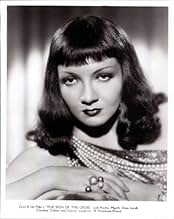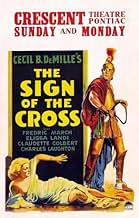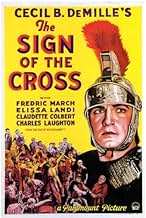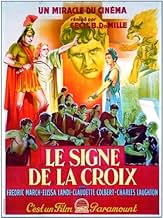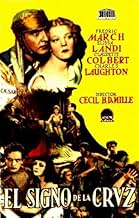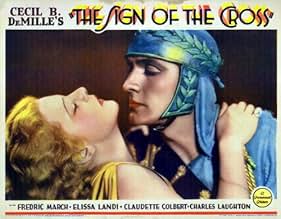CALIFICACIÓN DE IMDb
6.8/10
2.9 k
TU CALIFICACIÓN
Un soldado romano se debate entre su amor por una mujer cristiana y su lealtad al emperador Nerón.Un soldado romano se debate entre su amor por una mujer cristiana y su lealtad al emperador Nerón.Un soldado romano se debate entre su amor por una mujer cristiana y su lealtad al emperador Nerón.
- Dirección
- Guionistas
- Elenco
- Nominado a 1 premio Óscar
- 3 premios ganados y 1 nominación en total
Joyzelle Joyner
- Ancaria
- (as Joyzelle)
Robert Seiter
- Philodemus
- (as Robert Manning)
Opiniones destacadas
Great old DeMille flick about the persecution of Christians in ancient Rome. The movie starts with Emperor Nero (Charles Laughton) laughing and playing music while Rome burns. When someone reminds him that the people might hold Nero responsible, he quickly decides to blame the unpopular believers of the new Christian religion. As Christians are being rounded up and killed, Roman prefect Marcus (Fredric March) falls in love with a Christian girl (Elissa Landi). This doesn't sit well with Empress Poppaea (Claudette Colbert), who's in love with Marcus, and she conspires to have the girl arrested.
Charles Laughton gives an outrageously hammy performance and I loved every second of it. I wish he had been in the film a lot more. Fredric March is good, as always. Lovely Elissa Landi does an admirable job in probably her biggest role but she's eclipsed by Claudette Colbert. What this film is perhaps most famous for is the scene where Colbert takes a bath in donkey milk, in which we see quite a bit of what God gave Ms. Colbert to work with. She's a beautiful woman and it's a very sexy scene. The sets and costumes are great, as one expects from a Cecil B. DeMille picture. It's just a really good film, entertaining and dramatic, with some provocative bits of sex and violence that will surely please pre-Code fans. If for no other reason, see it for Colbert.
Charles Laughton gives an outrageously hammy performance and I loved every second of it. I wish he had been in the film a lot more. Fredric March is good, as always. Lovely Elissa Landi does an admirable job in probably her biggest role but she's eclipsed by Claudette Colbert. What this film is perhaps most famous for is the scene where Colbert takes a bath in donkey milk, in which we see quite a bit of what God gave Ms. Colbert to work with. She's a beautiful woman and it's a very sexy scene. The sets and costumes are great, as one expects from a Cecil B. DeMille picture. It's just a really good film, entertaining and dramatic, with some provocative bits of sex and violence that will surely please pre-Code fans. If for no other reason, see it for Colbert.
Believe it or not some sort of code did exist during the pre-Code era but no one felt obliged to follow it. Although lapped up by audiences the excesses on display in this extraordinary opus proved too much to bear in certain quarters and undeniably hastened the formation of the Hays Code and the crackpot Catholic League of Decency. One would hazard a guess that it is not so much the unspeakable cruelty depicted here that caused such moral outrage but the skimpy costumes and the hip-swivelling cooch dance by Joyzelle Joyner with its distinctly lesbian overtones.
Piety and Paganism are in direct opposition here and although Mr. De Mille is seen to be on the side of the angels he is astutely aware of the box office potential of depravity and debauchery.
What should really concern an objective cinéphile is how well-made the film is and how well it has held up over nine decades. The cinematography is lustrous courtesy of Karl Struss, one of the greatest pictorialists in the history of cinema whilst Mitchell Leisen's art and costume design is exemplary. The plot is not entirely original of course as the play by Wilson Barratt from which it is taken had been strongly influenced by the novel 'Quo Vadis?' of Henryk Sienkiewicz. Here the ill-fated lovers are played by Fredric March and Elissa Landi, both of whom do their very best in one-dimensional roles. The classy Miss Landi's portrayal is virtuous without being self-righteous and her anguished cry: "Dear Christ, why?" really touches the heart. A relatively small amount of screen time is allotted to Charles Laughton and Claudette Colbert as Nero and Poppaea but they certainly make the most of it. Miss Colbert is utterly bewitching here and supremely sensuous which makes her the obvious choice to play Cleopatra for the same director two years later. Apparently de Mille was perplexed by the idiosyncratic Mr. Laughton and gave up trying to direct him. Left to his own devices his performance is touched by genius and we are obliged to film historian David Thomson for describing Laughton's interpretation as 'the most flagrant and fleshy portrait of an abandoned homosexual spirit seen in a Hollywood film until that time.'
Although not for the faint hearted this piece is arguably Cecil B. De Mille's finest achievement.
Piety and Paganism are in direct opposition here and although Mr. De Mille is seen to be on the side of the angels he is astutely aware of the box office potential of depravity and debauchery.
What should really concern an objective cinéphile is how well-made the film is and how well it has held up over nine decades. The cinematography is lustrous courtesy of Karl Struss, one of the greatest pictorialists in the history of cinema whilst Mitchell Leisen's art and costume design is exemplary. The plot is not entirely original of course as the play by Wilson Barratt from which it is taken had been strongly influenced by the novel 'Quo Vadis?' of Henryk Sienkiewicz. Here the ill-fated lovers are played by Fredric March and Elissa Landi, both of whom do their very best in one-dimensional roles. The classy Miss Landi's portrayal is virtuous without being self-righteous and her anguished cry: "Dear Christ, why?" really touches the heart. A relatively small amount of screen time is allotted to Charles Laughton and Claudette Colbert as Nero and Poppaea but they certainly make the most of it. Miss Colbert is utterly bewitching here and supremely sensuous which makes her the obvious choice to play Cleopatra for the same director two years later. Apparently de Mille was perplexed by the idiosyncratic Mr. Laughton and gave up trying to direct him. Left to his own devices his performance is touched by genius and we are obliged to film historian David Thomson for describing Laughton's interpretation as 'the most flagrant and fleshy portrait of an abandoned homosexual spirit seen in a Hollywood film until that time.'
Although not for the faint hearted this piece is arguably Cecil B. De Mille's finest achievement.
THE SIGN OF THE CROSS (Paramount, 1932), directed by Cecil B. DeMille, returns its director to the genre to what he's best known, the religious spectacle, his first since THE KING OF KINGS (Pathe, 1927) starring H.B. Warner as Jesus the Christ. While this title certainly indicates another retelling into the life of Christ, the script, taken from an old play by Wilson Barrett, focuses more on Christians following in the teachings of Jesus years after His crucifixion, only to face suffering and prosecution for their faith.
The setting is 64 A.D. where the Emperor Nero (Charles Laughton) is introduced playing his lyre while watching in laughter the flames raging through the city of Rome. Although responsible for starting the fire, Nero places the blame on the Christians, arranging for his guards to have them placed under arrest. His wife, Poppara (Claudette Colbert), is an adulteress whose only desire is the manly Marcus Superbus (Fredric March), a prefect of Rome, but cannot put her hold on him after learning from Dacia (Vivian Tobin) of his love for Mercia (Elissa Landi), a Christian girl. As much as Marcus believes "Christianity is stupid," he tries his best to persuade Mercia to renounce her faith and marry him. Tigellinus (Ian Keith), Marcus' rival, sees an opportunity in making trouble for them both.
With crime dramas, drawing room comedies and/or social related issues as common theme during the Depression era, THE SIGN OF THE CROSS was something out of the ordinary. In true DeMille fashion, THE SIGN OF THE CROSS is not only a 128 minute spectacle with a three minute intermission in the midway point, but a large-scale production with lavish sets and cast of thousands accurately costumed according to its time structure. Of the performers in this Biblical story, Elissa Landi, the central character, seems out of place with her 1932 head-dress while Claudette Colbert, in her first "bad girl" role, quite evident with her lipstick and pencil drawn eyelashes, has her cherished moment bathing in a pool of milk gulped along side by two kittens at a distance. Fredric March as the Roman soldier who rules with the cracking of his whip, physically makes a convincing Marcus, though some of his badly scripted dialog, along with others in the cast, may provoke laughter for any contemporary viewer. Charles Laughton's Nero is exceptional, right down to his curly hair with added putty in the middle of his nose adding sharpness to his cruel facial expression. Although his scenes are regrettably limited, Laughton simply stands out, especially as he watches in sleepy-eyed boredom the slaughter of victims at the arena as he sits back eating large portions of food. Other members in the large cast include Tommy Conlan as Stephanus, the teenage Christian boy; Nat Pendleton, Arthur Hohl, Charles Middleton; lions, tigers, crocodiles and elephants as uncredited extras.
As much as the plot was reworked into the MGM spectacle of QUO VADIS (1951) starring Robert Taylor as Marcus; with Deborah Kerr and Peter Ustinov giving a tour-da-force performance as Nero, nothing can compare with the intense arena sequence found in THE SIGN OF THE CROSS. Graphic, then and now, this sequence, along with "The Naked Moon" dance performed by the wicked Ancaria (Joyzelle Joyner), was all that was missing when THE SIGN OF THE CROSS was not only reissued to theaters in 1944, but when sold to commercial television around the 1960s. In its place was a ten minute prologue written by Dudley Nichols, set during World War II with the cast featuring Stanley Ridges (Chaplain Thomas Lloyd); Arthur Shields (Captain James Costello); James Millican (Captain Kevin Driscoll); William Forrest (Colonel Hugh Mason); Tom Tully (Hoboken); Oliver Thorndyke (Lieutenant Roger Hammond); and Joel Allen. The new opening revolves around bombardiers being assigned on a dangerous mission and heading out to their destination. As the airplane flies over the Colosseum, a discussion about to the prosecution of Christians under Nero's regime leads to a flashback and events that takes place.
It wasn't until March 14, 1993, when American Movie Classics cable channel presented the original uncut 1932 theatrical release of THE SIGN OF THE CROSS that was obtained from the DeMille estate, and played it as part of AMC's initial Film Preservation Society festival. Without these missing scenes, THE SIGN OF THE CROSS would have been hopelessly dull and talkie, such as the case with the 1944 reissue that had circulated for nearly half a century. In 1995, Universal Home Video distributed the now uncensored 1932 version to home video and then to DVD in 2006. After AMC ceased airing THE SIGN OF THE CROSS in 1999, Turner Classic Movies picked up its option by airing this DeMille epic where it played from occasionally from 2004 to 2007. Regardless of its flaws, THE SIGN OF THE CROSS is prime DeMille, best suited for viewing during the season of Lent or Good Friday. Hail Caesar!! (***1/2)
The setting is 64 A.D. where the Emperor Nero (Charles Laughton) is introduced playing his lyre while watching in laughter the flames raging through the city of Rome. Although responsible for starting the fire, Nero places the blame on the Christians, arranging for his guards to have them placed under arrest. His wife, Poppara (Claudette Colbert), is an adulteress whose only desire is the manly Marcus Superbus (Fredric March), a prefect of Rome, but cannot put her hold on him after learning from Dacia (Vivian Tobin) of his love for Mercia (Elissa Landi), a Christian girl. As much as Marcus believes "Christianity is stupid," he tries his best to persuade Mercia to renounce her faith and marry him. Tigellinus (Ian Keith), Marcus' rival, sees an opportunity in making trouble for them both.
With crime dramas, drawing room comedies and/or social related issues as common theme during the Depression era, THE SIGN OF THE CROSS was something out of the ordinary. In true DeMille fashion, THE SIGN OF THE CROSS is not only a 128 minute spectacle with a three minute intermission in the midway point, but a large-scale production with lavish sets and cast of thousands accurately costumed according to its time structure. Of the performers in this Biblical story, Elissa Landi, the central character, seems out of place with her 1932 head-dress while Claudette Colbert, in her first "bad girl" role, quite evident with her lipstick and pencil drawn eyelashes, has her cherished moment bathing in a pool of milk gulped along side by two kittens at a distance. Fredric March as the Roman soldier who rules with the cracking of his whip, physically makes a convincing Marcus, though some of his badly scripted dialog, along with others in the cast, may provoke laughter for any contemporary viewer. Charles Laughton's Nero is exceptional, right down to his curly hair with added putty in the middle of his nose adding sharpness to his cruel facial expression. Although his scenes are regrettably limited, Laughton simply stands out, especially as he watches in sleepy-eyed boredom the slaughter of victims at the arena as he sits back eating large portions of food. Other members in the large cast include Tommy Conlan as Stephanus, the teenage Christian boy; Nat Pendleton, Arthur Hohl, Charles Middleton; lions, tigers, crocodiles and elephants as uncredited extras.
As much as the plot was reworked into the MGM spectacle of QUO VADIS (1951) starring Robert Taylor as Marcus; with Deborah Kerr and Peter Ustinov giving a tour-da-force performance as Nero, nothing can compare with the intense arena sequence found in THE SIGN OF THE CROSS. Graphic, then and now, this sequence, along with "The Naked Moon" dance performed by the wicked Ancaria (Joyzelle Joyner), was all that was missing when THE SIGN OF THE CROSS was not only reissued to theaters in 1944, but when sold to commercial television around the 1960s. In its place was a ten minute prologue written by Dudley Nichols, set during World War II with the cast featuring Stanley Ridges (Chaplain Thomas Lloyd); Arthur Shields (Captain James Costello); James Millican (Captain Kevin Driscoll); William Forrest (Colonel Hugh Mason); Tom Tully (Hoboken); Oliver Thorndyke (Lieutenant Roger Hammond); and Joel Allen. The new opening revolves around bombardiers being assigned on a dangerous mission and heading out to their destination. As the airplane flies over the Colosseum, a discussion about to the prosecution of Christians under Nero's regime leads to a flashback and events that takes place.
It wasn't until March 14, 1993, when American Movie Classics cable channel presented the original uncut 1932 theatrical release of THE SIGN OF THE CROSS that was obtained from the DeMille estate, and played it as part of AMC's initial Film Preservation Society festival. Without these missing scenes, THE SIGN OF THE CROSS would have been hopelessly dull and talkie, such as the case with the 1944 reissue that had circulated for nearly half a century. In 1995, Universal Home Video distributed the now uncensored 1932 version to home video and then to DVD in 2006. After AMC ceased airing THE SIGN OF THE CROSS in 1999, Turner Classic Movies picked up its option by airing this DeMille epic where it played from occasionally from 2004 to 2007. Regardless of its flaws, THE SIGN OF THE CROSS is prime DeMille, best suited for viewing during the season of Lent or Good Friday. Hail Caesar!! (***1/2)
Hollywood legend has it that DeMille cast Claudette Colbert as Poppaea by asking her if she'd like to play the "wickedest woman in the world". Who could refuse an offer like that? There are already quite a few excellent (and fun) reviews in this column now, but in view of the DVD release I'd like to add a few things. This lavish picture shows DeMille at his best, worst, most decadent and most unusual. I first saw the expurgated World War II era re-release on TV ages ago, and wasn't much impressed. My father said they'd bowdlerized it a lot, so I was curious to see the 1932 original when it appeared on VHS a few years back. "Astound Me" Diaghilev once famously said to Cocteau; and astounded I was. I was expecting a lot more craziness, but I wasn't expecting to see elephants stepping on men's heads or naked women being eaten by crocodiles. Released in December 1932 it is marginally a pre-code movie, but surely only DeMille could have gotten away with it. This movie has nothing to do with Hollywood of the Thirties; this is Hollywood of the Twenties having one last outrageous fling, with all its sex, drugs, decadence, and all round insanity. The movie plays very much like a silent; perhaps it should have been a silent, thus sparing us its greatest defect, which is some of the worst dialog ever perpetrated. Fredric March as Marcus, the male lead, struggles manfully with awful lines throughout; but it is the visual aspect which dominates one's attention. Consider Colbert's legendary bath in a veritable swimming pool filled with milk (and she's really naked under all that milk). A friend, played by Vivian Tobin with kittenish glee, arrives; they exchange a few verbal barbs worthy of a pair of snarky teenagers, then Poppaea simply says "Take off your clothes. Get in here and tell me all about it." Anyone who thinks the naughty implications of this were inadvertent in innocent old 1932 hasn't spent much time in Hollywood Babylon, to say nothing of Hollywood Rome. Colbert is a delight throughout; her scenes with Fredric March play as high comedy. As he desperately tries to assert his nobility and self control, Colbert effortlessly demolishes his dignity with the perfect lazy grace of a leopardess. And let's not forget Charles Laughton, whose Nero is a masterpiece of omnisexual megalomania. Only Peter Ustinov in the 1951 "Quo Vadis" could better him.
This is on the surface a standard lions vs. Christians epic, but it ain't one to take your Sunday School class to. Under no circumstances should this be viewed by kids, even today. Much of the imagery is equivocal, to put it politely, especially during the big arena show that fills the last half hour. And then there's Marcus' big party, where Joyzelle Joyner performs a dance that is startlingly obscene for 1932.
All of this is ravishingly photographed by cameraman Karl Struss, one of the great artists of monochrome, who makes every shot a work of art. There is one scene in the house occupied by Mercia and her aged guardian, where the old man is seen in a hallway with a gate and small yard beyond; in the yard is an urn. The whole shot is lit by a single brilliant light blasting down on the urn, with bounce boards sending the light gently into the house. This violates all the rules of how to light a scene, but the effect is magical. A quick word should also be put in for Rudolph Kopp, who supplied the music (curiously uncredited); he actually has a go at recreating an authentic ancient Roman sound (no actual ancient Roman music survives).
But the core of the picture is the last part, the ultimate Roman circus. DeMille does something genuinely startling here. First he invites us, a little salaciously, to watch the spectacle, which begins with gladiatorial combat, but proceeds to darker and darker exhibits, many of which are genuinely disturbing (I wasn't kidding about the naked women and the crocodiles; wait until you see the Gaulish Amazon women vs. the Pygmies). As it gets more and more evil, we keep cutting to vivid closeups of the audience that we have been invited to join; some excited, some revolted, some merciless, some bored to distraction, some filled with pity, some sadistic, some almost drooling with voyeurism; they are us, and we are them. DeMille has had the effrontery to show us our own faces as we feast our eyes on all this exquisitely photographed mayhem. It's not easy to watch, and I know of nothing else quite like it prior to Stanley Kubrick.
This is on the surface a standard lions vs. Christians epic, but it ain't one to take your Sunday School class to. Under no circumstances should this be viewed by kids, even today. Much of the imagery is equivocal, to put it politely, especially during the big arena show that fills the last half hour. And then there's Marcus' big party, where Joyzelle Joyner performs a dance that is startlingly obscene for 1932.
All of this is ravishingly photographed by cameraman Karl Struss, one of the great artists of monochrome, who makes every shot a work of art. There is one scene in the house occupied by Mercia and her aged guardian, where the old man is seen in a hallway with a gate and small yard beyond; in the yard is an urn. The whole shot is lit by a single brilliant light blasting down on the urn, with bounce boards sending the light gently into the house. This violates all the rules of how to light a scene, but the effect is magical. A quick word should also be put in for Rudolph Kopp, who supplied the music (curiously uncredited); he actually has a go at recreating an authentic ancient Roman sound (no actual ancient Roman music survives).
But the core of the picture is the last part, the ultimate Roman circus. DeMille does something genuinely startling here. First he invites us, a little salaciously, to watch the spectacle, which begins with gladiatorial combat, but proceeds to darker and darker exhibits, many of which are genuinely disturbing (I wasn't kidding about the naked women and the crocodiles; wait until you see the Gaulish Amazon women vs. the Pygmies). As it gets more and more evil, we keep cutting to vivid closeups of the audience that we have been invited to join; some excited, some revolted, some merciless, some bored to distraction, some filled with pity, some sadistic, some almost drooling with voyeurism; they are us, and we are them. DeMille has had the effrontery to show us our own faces as we feast our eyes on all this exquisitely photographed mayhem. It's not easy to watch, and I know of nothing else quite like it prior to Stanley Kubrick.
Rome - First Century A. D. Nero, the mad Emperor & Poppaea, his vile Empress, engage in every sort of vice & degradation. Wanton cruelty becomes a spectator sport and virtue & innocence are denigrated. Slowly, however, a new Power is growing. People calling themselves Christians are secretly spreading their Faith ever more widely. They are horribly persecuted, but they continue to multiply. Which will eventually triumph - the might of Imperial Rome, or the gentle ones who follow THE SIGN OF THE CROSS?
This Cecil B. DeMille epic is a vivid retelling of the struggles of the first Christians. Paramount gave the film a lavish production and DeMille wrings every drop of piety & puerile interest possible from the plot. Fredric March is stalwart as the Roman official who falls in love with a beautiful Christian girl. While his ultimate conversion wouldn't convince the average modern Baptist, he holds his own in scenes with other performers whom are allowed to behave outrageously. Elissa Landi is sweet as the virtuous Believer, effectively underplaying her role.
`Do you want to play the most wicked woman in the world?' DeMille asked Claudette Colbert one day on the studio lot. She did & she does memorably, from her eye-popping milk bath scene to her revenge on her would-be lover. Sniveling, whining and wearing a huge fake nose, Charles Laughton is pure effeminate evil as Nero (notice his catamite), a foul blot on the face of humanity & stealing all his scenes from everyone else. History tells us that Nero eventually murdered Poppaea by stomping her to death...
Ian Keith is enjoyable as an unpunished villain. Ferdinand Gottshalk & Vivian Tobin are effectively degraded as Roman bacchants. Film mavens will recognize the voice of John Carradine, calling `We who are about to die, salute you!' out of the arena to Nero; he can later be spotted in the role of a Christian martyr ascending the dungeon stairs to his death.
DeMille had just returned to Paramount from a 3-year, 3-picture stint at MGM, where he was remarkably subdued. Back at his home studio he was allowed more license. Wrapping a little sermon up in a lot of sin, he filled this pre-Production Code drama with plenty of the latter. When THE SIGN OF THE CROSS was re-released in 1944, many cuts had to be made. The film now having been restored, it's not difficult to guess which sections those were. The Dance of the Naked Moon & much of the antics in the final arena sequence are beyond the bounds of good taste, but certainly not beyond the bounds of Cecil B. DeMille.
This Cecil B. DeMille epic is a vivid retelling of the struggles of the first Christians. Paramount gave the film a lavish production and DeMille wrings every drop of piety & puerile interest possible from the plot. Fredric March is stalwart as the Roman official who falls in love with a beautiful Christian girl. While his ultimate conversion wouldn't convince the average modern Baptist, he holds his own in scenes with other performers whom are allowed to behave outrageously. Elissa Landi is sweet as the virtuous Believer, effectively underplaying her role.
`Do you want to play the most wicked woman in the world?' DeMille asked Claudette Colbert one day on the studio lot. She did & she does memorably, from her eye-popping milk bath scene to her revenge on her would-be lover. Sniveling, whining and wearing a huge fake nose, Charles Laughton is pure effeminate evil as Nero (notice his catamite), a foul blot on the face of humanity & stealing all his scenes from everyone else. History tells us that Nero eventually murdered Poppaea by stomping her to death...
Ian Keith is enjoyable as an unpunished villain. Ferdinand Gottshalk & Vivian Tobin are effectively degraded as Roman bacchants. Film mavens will recognize the voice of John Carradine, calling `We who are about to die, salute you!' out of the arena to Nero; he can later be spotted in the role of a Christian martyr ascending the dungeon stairs to his death.
DeMille had just returned to Paramount from a 3-year, 3-picture stint at MGM, where he was remarkably subdued. Back at his home studio he was allowed more license. Wrapping a little sermon up in a lot of sin, he filled this pre-Production Code drama with plenty of the latter. When THE SIGN OF THE CROSS was re-released in 1944, many cuts had to be made. The film now having been restored, it's not difficult to guess which sections those were. The Dance of the Naked Moon & much of the antics in the final arena sequence are beyond the bounds of good taste, but certainly not beyond the bounds of Cecil B. DeMille.
¿Sabías que…?
- TriviaCecil B. DeMille was pressured to drop Ancaria's seductive dance in the orgy scene by Will H. Hays of the Hays Office, but DeMille adamantly refused. Still, censors often cut out gruesome parts of the film, particularly, the cart carrying dead bodies out of the arena, a gorilla dancing around a semi-nude girl, elephants stomping Christians and picking them up with their tusks, crocodiles about to eat a bound girl, etc. These scenes are all in the restored version.
- ErroresWe see a woman tied up in the Coliseum as crocodiles are set loose on her. They are clearly alligators (broad snout), which were unknown to Europeans until Columbus's time, 15 centuries later. Only two countries have alligators: The United States and China.The Romans never went to either place.
- Versiones alternativasRe-released in 1944, with some cuts (sex and sadism scenes) and preceded by a nine minute prologue, set in present time with a WWII theme. This re-release version runs 118 minutes.
- ConexionesEdited into Through the Centuries (1933)
- Bandas sonorasChristian Hymn No.1
(1932) (uncredited)
Music and Lyrics by Rudolph G. Kopp
Sung a cappella by Christians at the meeting
Reprised by them after their capture and at the arena
Sung a cappella by Elissa Landi and Tommy Conlon
Played and sung offscreen at the end
Selecciones populares
Inicia sesión para calificar y agrega a la lista de videos para obtener recomendaciones personalizadas
- How long is The Sign of the Cross?Con tecnología de Alexa
Detalles
Taquilla
- Total en EE. UU. y Canadá
- USD 5,971,004
- Tiempo de ejecución2 horas 5 minutos
- Color
- Relación de aspecto
- 1.37 : 1
Contribuir a esta página
Sugiere una edición o agrega el contenido que falta


